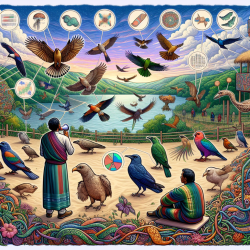Introduction
In the realm of speech-language pathology, data-driven decisions are crucial for optimizing therapeutic outcomes. But what if we could draw insights from unexpected sources, such as the conservation practices of Indigenous Mexican communities? A recent study, "Bird conservation status and cultural values in Indigenous Mexican communities: towards a bioculturally informed conservation policy," provides a fascinating lens through which we can enhance our practices. This blog explores how the findings from this research can inspire practitioners to improve their skills and encourage further research.
The Study in Focus
The study conducted by Alcántara-Salinas et al. (2022) investigates the intricate relationship between bird conservation status and cultural values in ten Indigenous Mexican communities. It highlights the role of ethnoornithology and ethnobiology in biocultural conservation, emphasizing the importance of recognizing birds with cultural value alongside those of special interest for biodiversity conservation.
Key Findings
- Indigenous communities provide refugia for nearly 70% of Mexican avifauna within a fraction of 1% of the national territory.
- The study identified a strong correlation (81.55% variation explained) between cultural importance and bird conservation status.
- Three categories of bioculturally prominent bird species were proposed: high, medium, and culturally significant species.
Implications for Practitioners
While the study focuses on birds, the underlying principles of integrating cultural values into conservation policies can be transformative for speech-language pathology. Here's how:
- Holistic Approach: Just as the study advocates for a biocultural approach, practitioners can adopt a holistic view that considers cultural and environmental factors in therapy.
- Cultural Sensitivity: Understanding the cultural significance of certain practices or symbols can enhance rapport and engagement with clients from diverse backgrounds.
- Data-Driven Adaptation: The study's use of correspondence analysis to correlate cultural and conservation values can inspire practitioners to employ data-driven methods to tailor interventions.
Encouraging Further Research
The study opens avenues for further research in speech-language pathology, particularly in understanding the cultural dimensions of communication disorders. Practitioners are encouraged to explore the cultural contexts of their clients and integrate these insights into their practice.
Conclusion
The research on bird conservation in Indigenous Mexican communities offers valuable lessons for speech-language pathologists. By embracing a biocultural approach, practitioners can enhance their skills, improve client outcomes, and contribute to a more inclusive and effective therapeutic environment.
To read the original research paper, please follow this link: Bird conservation status and cultural values in Indigenous Mexican communities: towards a bioculturally informed conservation policy.










